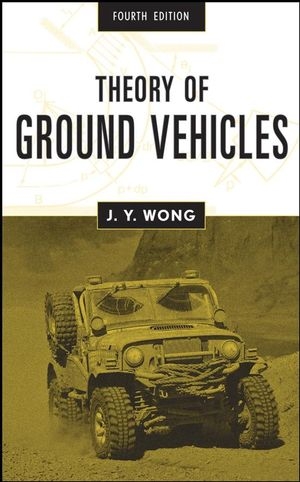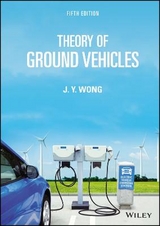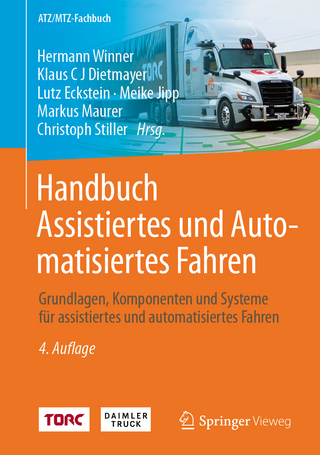
Theory of Ground Vehicles 4e
John Wiley & Sons Inc (Verlag)
978-0-470-17038-0 (ISBN)
- Titel erscheint in neuer Auflage
- Artikel merken
Technology/Engineering/Automotive Engineering for advancing ground vehicle mobility A standard text and reference for both the educational and professional communities, Theory of Ground Vehicles gives aspiring and practicing engineers a fundamental understanding of the critical factors affecting the performance, handling, and ride essential to the development and design of ground vehicles. In view of the growing concerns over environmental impact, energy efficiency, and safety, this new Fourth Edition has been revised and expanded to address these issues and other developments in the field.
Retaining the contents and format of previous editions, the Fourth Edition introduces new material to reflect recent advances in ground transportation technology, including: * Computer-aided methods for design and performance evaluation of off-road vehicles and their practical applications * Emissions and fuel economy * Hybrid electric drives and fuel cells and their operating principles * Selection of vehicle configurations for off-road operations * Road vehicle stability control * ISO 2631-1:1997 and its applications to evaluating vehicle ride characteristics As in previous editions, this book focuses on applying engineering principles to the analysis of vehicle behavior. A large number of practical examples and problems are included throughout to help readers bridge the gap between theory and practice. With its broad coverage and pedagogical aids, Theory of Ground Vehicles, Fourth Edition remains the text of choice for students, engineers, and researchers wishing to master and apply basic theory to solve real-world, road and off-road vehicle mobility problems.
J. Y. Wong, PhD, DSc, is Professor Emeritus and Distinguished Research Professor in the Department of Mechanical and Aerospace Engineering, Carleton University, Ottawa, Canada. Internationally recognized in the field of road and off-road vehicle dynamics, he is also the author of Terramechanics and Off-Road Vehicles and is a member of the editorial boards of a number of international journals. He has received numerous awards from learned societies for his research accomplishments.
Preface. Preface to the Third Edition. Preface to the Second Edition. Preface to the First Edition. Conversion Factors. Nomenclature. Introduction. 1. MECHANICS OF PNEUMATIC TIRES. 1.1 Tire Forces and Moments. 1.2 Rolling Resistance of Tires. 1.3 Tractive (Braking) Effort and Longitudinal Slip (Skid). 1.4 Cornering Properties of Tires. 1.4.1 Slip Angle and Cornering Force. 1.4.2 Slip Angle and Aligning Torque. 1.4.3 Camber and Camber Thrust. 1.4.4 Characterization of Cornering Behavior of. Tires. 1.5 Performance of Tires on Wet Surfaces. 1.6 Ride Properties of Tires. References. Problems. 2. MECHANICS OF VEHICLE-TERRAIN INTERACTION--TERRAMECHANICS. 2.1 Distribution of Stresses in the Terrain Under Vehicular Loads. 2.2 Applications of the Theory of Plastic Equilibrium to the Mechanics of Vehicle--Terrain Interaction. 2.3 Empirical Methods for Predicting Off-Road Vehicle Performance. 2.3.1 Empirical Methods Based on the Cone Index. 2.3.2 Empirical Methods Based on the Mean Maximum Pressure. 2.4 Measurement and Characterization of Terrain Response. 2.4.1 Characterization of Pressure-Sinkage Relationship. 2.4.2 Characterization of the Response to Repetitive Loading. 2.4.3 Characterization of the Shear Stress-Shear Displacement Relationship. 2.5 A Simplified Method for Analysis of Tracked Vehicle Performance. 2.5.1 Motion Resistance of a Track. 2.5.2 Tractive Effort and Slip of a Track. 2.6 A Computer-Aided Method for Evaluating the Performance of Vehicles with Flexible Tracks. 2.6.1 Approach to the Prediction of Normal Pressure Distribution under a Track. 2.6.2 Approach to the Prediction of Shear Stress Distribution under a Track. 2.6.3 Prediction of Motion Resistance and Drawbar Pull as Functions of Track Slip. 2.6.4 Experimental Substantiation. 2.6.5 Applications to Parametric Analysis and Design Optimization. 2.7 A Computer-Aided Method for Evaluating the Performance of Vehicles with Long-Pitch Link Tracks. 2.7.1 Basic Approach. 2.7.2 Experimental Substantiation. 2.7.3 Applications to Parametric Analysis and Design Optimization. 2.8 Methods for Parametric Analysis of Wheeled Vehicle Performance. 2.8.1 Motion Resistance of a Rigid Wheel. 2.8.2 Motion Resistance of a Pneumatic Tire. 2.8.3 Tractive Effort and Slip of a Wheel. 2.9 A Computer-Aided Method for Evaluating the Performance of Off-Road Wheeled Vehicles. 2.9.1 Basic Approach. 2.9.2 Experimental Substantiation. 2.9.3 Applications to Parametric Analysis. 2.10 Finite Element and Discrete Element Methods for the Study of Vehicle-Terrain Interaction. 2.10.1 The Finite Element Method. 2.10.2 The Discrete (Distinct) Element Method. References. Problems. 3. PERFORMANCE CHARACTERISTICS OF ROAD VEHICLES. 3.1 Equation of Motion and Maximum Tractive Effort. 3.2 Aerodynamic Forces and Moments. 3.3 Vehicle Power Plant and Transmission Characteristics. 3.3.1 Internal Combustion Engines. 3.3.2 Electric Drives. 3.3.3 Hybrid Drives. 3.3.4 Fuel Cells. 3.3.5 Transmission Characteristics. 3.4 Vehicle Power Plant and Transmission Characteristics. 3.4.1 Power Plant Characteristics. 3.4.2 Transmission Characteristics. 3.5 Prediction of Vehicle Performance. 3.5.1 Acceleration Time and Distance. 3.5.2 Gradability. 3.6 Operating Fuel Economy. 3.7 Engine and Transmission Matching. 3.8 Braking Performance. 3.8.1 Braking Characteristics of a Two-Axle. Vehicle. 3.8.2 Braking Efficiency and Stopping Distance. 3.8.3 Braking Characteristics of a Tractor-Semitrailer. 3.8.4 Antilock Brake Systems. 3.8.5 Traction Control Systems. References. Problems. 4. PERFORMANCE CHARACTERISTICS OF OFF-ROAD VEHICLES. 4.1 Drawbar Performance. 4.1.1 Drawbar Pull and Drawbar Power. 4.1.2 Tractive Efficiency. 4.1.3 Four Wheel Drive. 4.1.5 Coefficient of Traction. 4.1.4 Weight-to-Power Ratio for Off-Road Vehicles. 4.2 Fuel Economy of Cross-Country Operations. 4.3 Transport Productivity and Transport Efficiency. 4.4 Mobility Map and Mobility Profile. 4.5 Selection of Vehicle Configurations for Off-Road Operations. References. Problems. 5. HANDLING CHARACTERISTICS OF ROAD VEHICLES. 5.1 Steering Geometry. 5.2 Steady-State Handling Characteristics of a Two-Axle Vehicle. 5.2.1 Neutral Steer. 5.2.2 Understeer. 5.2.3 Oversteer. 5.3 Steady-State Response to Steering Input. 5.3.1 Yaw Velocity Response. 5.3.2 Lateral Acceleration Response. 5.3.3 Curvature Response. 5.4 Testing of Handling Characteristics. 5.4.1 Constant Radius Test. 5.4.2 Constant Speed Test. 5.4.3 Constant Steer Angle Test. 5.5 Transient Response Characteristics. 5.6 Directional Stability. 5.6.1 Criteria for Directional Stability. 5.6.2 Vehicle Stability Control. 5.7 Steady-State Handling Characteristics of a Tractor-Semitrailer. 5.8 Simulation Models for the Directional Behavior of Articulated Road Vehicles. References. Problems. 6. STEERING OF TRACKED VEHICLES. 6.1 Simplified Analysis of the Kinetics of Skid-Steering. 6.2 Kinematics of Skid-Steering. 6.3 Skid-Steering at High Speeds. 6.4 A General Theory for Skid-Steering on Firm Ground. 6.4.1 Shear Displacement on the Track-Ground Interface. 6.4.2 Kinetics in a Steady-State Turning Maneuver. 6.4.3 Experimental Substantiation. 6.4.4 Coefficient of Lateral Resistance. 6.5 Power Consumption of Skid-Steering. 6.6 Steering Mechanisms for Tracked Vehicles. 6.6.1 Clutch/Brake Steering System. 6.6.2 Controlled Differential Steering System. 6.6.3 Planetary Gear Steering System. 6.7 Articulated Steering. References. Problems. 7. VEHICLE RIDE CHARACTERISTICS. 7.1 Human Response to Vibration. 7.1.1 International Standard ISO 2631-1:1985. 7.1.2 International Standard ISO 2631-1:1997. 7.2 Vehicle Ride Models. 7.2.1 Two-Degree-of-Freedom Vehicle Model for Sprung and Unsprung Mass. 7.2.2 Numerical Methods for Determining the Response of a Quarter-Car Model to Irregular Surface Profile Excitation. 7.2.3 Two-Degree-of-Freedom Vehicle Model for Pitch and Bounce. 7.3 Introduction to Random Vibration. 7.3.1 Surface Elevation Profile as a Random Function. 7.3.2 Frequency Response Function. 7.3.3 Evaluation of Vehicle Vibration in Relation to the Ride Comfort Criterion. 7.4 Active and Semi-Active Suspensions. References. Problems. 8. INTRODUCTION TO AIR-CUSHION VEHICLES. 8.1 Air-Cushion Systems and Their Performance. 8.1.1 Plenum Chamber. 8.1.2 Peripheral Jet. 8.2 Resistance of Air-Cushion Vehicles. 8.3 Suspension Characteristics of Air-Cushion Systems. 8.3.1 Heave (or Bounce) Stiffness. 8.3.2 Roll Stiffness. 8.4 Directional Control of Air-Cushion Vehicles. References. Problems. Index.
| Erscheint lt. Verlag | 22.8.2008 |
|---|---|
| Verlagsort | New York |
| Sprache | englisch |
| Maße | 166 x 236 mm |
| Gewicht | 920 g |
| Themenwelt | Technik ► Fahrzeugbau / Schiffbau |
| Technik ► Maschinenbau | |
| ISBN-10 | 0-470-17038-7 / 0470170387 |
| ISBN-13 | 978-0-470-17038-0 / 9780470170380 |
| Zustand | Neuware |
| Haben Sie eine Frage zum Produkt? |
aus dem Bereich



